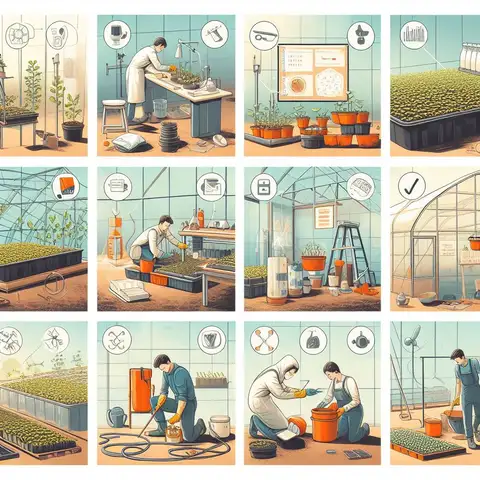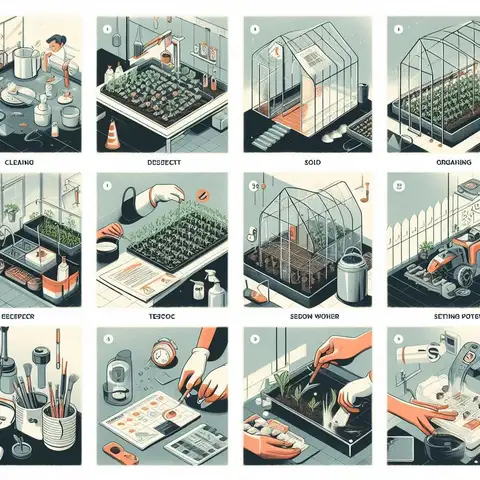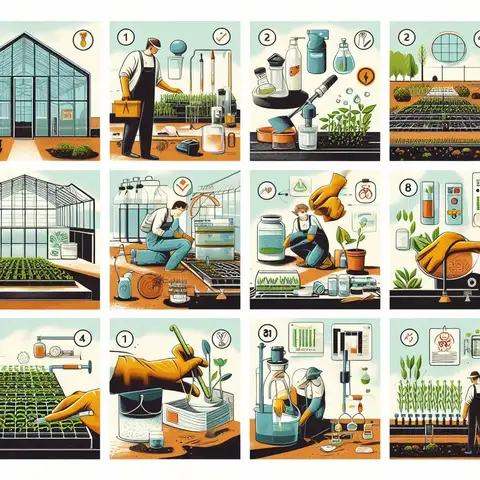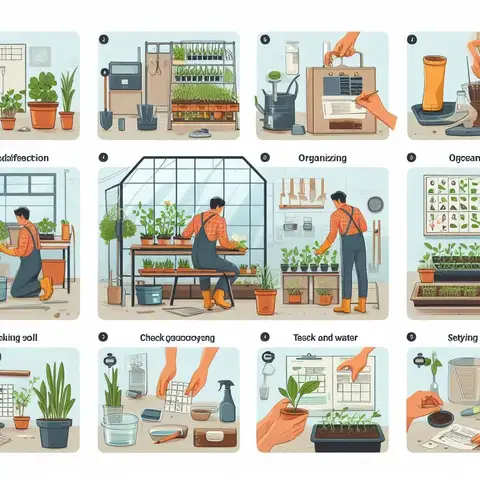If you love plants, a greenhouse planting is like a dream come true. It’s a special place where you can grow all kinds of plants, even when it’s too cold or hot outside. But wait! Before you start planting, you need to get your greenhouse ready. It is a big step that can make or break your gardening success.
Getting your greenhouse ready is like setting the stage for a big show. If the stage is set right, the show can go on. In the same way, your plants will only grow well if your greenhouse is prepared. You need to think about things like dirt quality, water, and even the air inside the greenhouse. So, Let’s Learn more about It.
What is a greenhouse planting?
A greenhouse planting is like a big see-through box made of glass or plastic. It’s a special place where you can grow plants all year long. It keeps plants warm and safe.
Why is it Good for Planting?
Grow All Year: You can start planting when it’s still cold outside and keep going even when it gets chilly in the fall.
More Plant Choices: You can grow plants that usually don’t grow where you live.
Fewer Bugs: It’s easier to keep bugs away when your plants are in a greenhouse.
Just Right: You can make sure your plants get the right amount of light, water, and warmth.
Save Space: You can put lots of plants in a small area by using shelves and hanging pots.
Safe from Bad Weather: Your plants won’t get hurt by wind, rain, or too much sun.
Grow More: Your plants will be healthier, and you’ll get more flowers or veggies.
Try New Things: You can try growing new kinds of plants or use new ways to help them grow better.
Tips for Successful Greenhouse Planting

Planting in a greenhouse can be a rewarding experience, but it also comes with its own set of challenges. To help you navigate these, here are some general tips and tricks for successful greenhouse planting.
1. Choose the Right Plants
Not all plants are suitable for greenhouse growing. Research and choose plants that will thrive in your specific greenhouse conditions.
2. Monitor Temperature and Humidity
Keep a close eye on the temperature and humidity levels in your greenhouse. Too much or too little of either can harm your plants.
3. Use High-Quality Soil
The soil in your greenhouse should be rich in nutrients. Consider using a soil test kit to determine what your soil lacks and amend it accordingly.
4. Proper Watering Technique
Overwatering or underwatering can be detrimental. Use a watering can or a drip irrigation system for even watering.
5. Pest Control
Keep an eye out for signs of pests like aphids or spider mites. Use organic pesticides or introduce natural predators like ladybugs.
6. Regular Pruning
Prune your plants regularly to remove dead or diseased parts and to encourage bushier growth.
7. Fertilize Wisely
Use the right type and amount of fertilizer for your specific plants. Too much fertilizer can lead to nutrient imbalances.
8. Maximize Light Exposure
Make sure all plants get enough light, especially in the winter months. Use reflective materials or grow lights if necessary.
9. Proper Spacing
Make sure to overcrowd your plants. Proper spacing ensures adequate air circulation, which reduces the risk of disease.
10. Keep It Clean
Sanitize your greenhouse regularly to prevent the spread of diseases. Remove any dead or diseased plants immediately.
Greenhouse Planting Schedule
Having a greenhouse planting schedule is crucial for maximizing your yield and keeping your plants healthy. It helps you know when to sow seeds, transplant seedlings, and harvest your crops. A well-planned schedule can make your greenhouse gardening more efficient and rewarding.
General Guidelines
Early Spring (February – March)
- Start seeds for cool-season crops like lettuce, spinach, and peas.
- Transplant any overwintered plants if needed.
Late Spring (April – May)
- Start seeds for warm-season crops like tomatoes, peppers, and cucumbers.
- Begin transplanting cool-season crops outside if you plan to.
Early Summer (June – July)
- Harvest early spring crops.
- Plant more warm-season crops for a late summer harvest.
Late Summer (August – September)
- Harvest warm-season crops.
- Start seeds for fall crops like kale and Swiss chard.
Autumn (October – November)
- Harvest late summer and fall crops.
- Prepare the soil for winter crops or cover crops.
Winter (December – January)
- Plant winter-hardy crops like certain lettuces and herbs.
- Start seeds for early spring crops.
Tips for Creating Your Schedule
- Know Your Zone: Understand your USDA hardiness zone to plan your schedule better.
- Rotate Crops: Don’t plant the same crop in the same spot year after year to prevent soil depletion.
- Record Keeping: Keep a gardening journal to track what works and what doesn’t.
- Adjust as Needed: Be prepared to adjust your schedule based on weather conditions and other unforeseen factors.
Greenhouse Planting Schedule by USDA Hardiness Zones
Greenhouse Planting Schedule for Zone 6
Early Spring (March)
- Start seeds for cool-season crops like lettuce and spinach.
Late Spring (May)
- Plant warm-season crops like tomatoes and peppers.
Early Fall (September)
- Harvest warm-season crops and plant fall crops like kale.
Winter (December)
- Plant winter-hardy crops and start seeds for early spring crops.
Greenhouse Planting Schedule for Zone 7
Early Spring (February – March)
- Start cool-season crops and transplant overwintered plants.
Late Spring (April – May)
- Plant warm-season crops and begin transplanting cool-season crops outside.
Early Fall (September)
- Harvest and plant fall crops.
Winter (November – December)
- Plant winter crops and prepare for spring greenhouse planting .
Greenhouse Planting Schedule for Zone 8
Early Spring (February)
- Start cool-season crops like lettuce and peas.
Late Spring (April)
- Plant warm-season crops like tomatoes and cucumbers.
Early Fall (August)
- Harvest warm-season crops and plant fall crops.
Winter (November)
- Plant winter-hardy crops and start seeds for spring crops.
Greenhouse Planting Schedule for Zone 9
Early Spring (January – February)
- Start cool-season crops and transplant overwintered plants.
Late Spring (March – April)
- Plant warm-season crops like peppers and tomatoes.
Early Fall (July – August)
- Harvest and plant fall crops like Swiss chard.
Winter (October – November)
- Plant winter crops and prepare the soil for spring planting.
What Types of Plants Are Best Suited for Greenhouse Planting?

When it comes to greenhouse planting, the sky’s the limit! However, some plants are particularly well-suited for greenhouse conditions. Here are some types of plants that thrive in a greenhouse environment:
Vegetables
- Tomatoes: They love the controlled climate and extended growing season.
- Cucumbers: Ideal for greenhouses as they require consistent temperatures.
- Peppers: Benefit from the warm, stable conditions.
Herbs
- Basil: Grows well in warm, sunny conditions.
- Mint: Enjoys the humidity a greenhouse can offer.
- Rosemary: Thrives in well-drained soil and sunny conditions.
Flowers
- Orchids: Require the high humidity and controlled conditions of a greenhouse.
- Geraniums: I love the consistent temperatures.
- Petunias: Grow well in full sun and well-drained soil.
Fruits
- Strawberries: Can be grown year-round in a greenhouse.
- Grapes: Vines do well in a controlled climate.
- Lemons: Dwarf lemon trees are perfect for a greenhouse planting .
Exotic Plants
- Carnivorous Plants, Such as Venus flytraps, enjoy the high humidity.
- Tropical Plants: Like hibiscus and bird of paradise, thrive in warm, humid conditions.
Seedlings
- Various Seedlings: A greenhouse is perfect for starting almost any type of plant from seed before transplanting them outdoors.
What Is the Best Time to Start Planting in a Greenhouse?

The best time to start planting in a greenhouse depends on several factors, including the type of plants you want to grow and your local climate. However, here are some general guidelines:
Early Spring
- Why: To get a head start on the growing season.
- Plants: Cold-hardy vegetables like lettuce, kale, and radishes.
Late Spring
- Why: Ideal for plants that need a warmer environment.
- Plants: Tomatoes, peppers, and cucumbers.
Summer
- Why: To grow plants that love heat and to prepare for fall crops.
- Plants: Herbs like basil, as well as flowers like petunias.
Early Fall
- Why: To extend the growing season for certain crops.
- Plants: Leafy greens and some root vegetables.
Winter
- Why: For year-round gardening, especially in heated greenhouses.
- Plants: Herbs, leafy greens, and some dwarf fruit trees.
Tips:
- Climate Check: Always consider your local climate and the specific needs of the plants you’re growing.
- Temperature: Make sure your greenhouse planting can maintain the required temperatures for your chosen plants.
- Light: Ensure adequate light levels, either through natural sunlight or supplemental lighting.
What Cannot Be Grown in a Greenhouse?
Here’s a look at what generally doesn’t thrive in a greenhouse planting setting:
Large Trees
- Why: Space limitations and root system needs.
Water-Intensive Crops
- Why: It may cause humidity issues.
- Examples: Rice, watercress.
Deep-Rooted Plants
- Why: Require deep soil beds.
- Examples: Some types of shrubs and trees.
Plants Requiring Special Pollinators
- Why: Limited access to natural pollinators.
- Examples: Some types of fruit trees.
Invasive Species
- Why: Can take over the greenhouse.
- Examples: Bamboo, mint.
Sun-Loving Plants
- Why: It may need more light, depending on the greenhouse.
- Examples: Some types of cacti and succulents.
Cold-Loving Plants
- Why: Greenhouses are generally warm.
- Examples: Plants native to alpine regions.
Plants Sensitive to Pests
- Why: Pests can become a bigger issue in a confined space.
- Examples: Plants that attract aphids or spider mites.
Tips:
- Research: Always research the specific needs of each plant before introducing it to your greenhouse.
- Trial and Error: Sometimes, it’s worth experimenting to see what works in your specific conditions.
How to Prepare for Greenhouse Planting

Preparing your greenhouse for planting is a crucial step in ensuring a successful growing season. Here’s a step-by-step guide to help you get your greenhouse ready for planting.
Step 1: Clean and Sanitize
Start by cleaning the greenhouse thoroughly. Remove any old plants, weeds, and debris. Sanitize the surfaces, including tables and tools, with a mild bleach solution to kill any lingering pathogens.
Step 2: Inspect for Repairs
Check the structure for any damages like cracks in the glass or tears in the plastic. Repair or replace as needed.
Step 3: Test the Soil
Use a soil test kit to check the pH and nutrient levels of the soil. Amend the soil based on the test results to provide the best environment for your plants.
Step 4: Set Up Irrigation
Install an efficient watering system. Drip irrigation is often recommended for greenhouses as it conserves water and provides consistent moisture.
Step 5: Install Shelving and Hooks
Set up shelves, hooks, and other storage solutions to maximize space and keep things organized.
Step 6: Control the Climate
Install thermostats, humidifiers, or dehumidifiers to regulate temperature and humidity. Make sure your ventilation system is working correctly.
Step 7: Plan Your Layout
Sketch out where each type of plant will go. Consider their light, space, and temperature needs when planning.
Step 8: Pre-treat the Soil
Before planting, pre-treat the soil with a slow-release fertilizer or compost to give your plants a nutrient boost.
Step 9: Planting
Follow the specific greenhouse planting guidelines for each type of plant you’re growing. Make sure to give them enough space to grow without crowding.
Step 10: Monitor and Adjust
Once everything is planted, keep a close eye on your greenhouse. Adjust temperature, humidity, and watering schedules as needed.
Final Thoughts and Encouragement
Getting your greenhouse ready for planting is a big deal. It helps your plants grow well and keeps them healthy.
If you want to start a greenhouse planting, now is a good time. The work you do at the start helps a lot later. You will get healthy plants and lots of good stuff from them. So, put on your work gloves and make your greenhouse ready for planting. Your plants will be happy, and so will you!
FAQs About Greenhouse Planting
Can I plant directly into the ground in a greenhouse?
Yes, you can. Just make sure the dirt is good for plants.
How Often Should I Water My Greenhouse Plants?
How much you need to water your plants changes based on what kind of plants you have, how hot or cold it is, and how wet the air is. Always check if the dirt feels dry or wet. Then you can know when to water your plants.
Do I Need to Give Food to My Greenhouse Plants?
Yes, you do! Plants in a greenhouse need special plant food. How often and what kind of food depends on what plants you are growing. Make sure to find out what your plants like best!
How can I control pests in my greenhouse?
You can use good bugs to eat the bad ones. Or you can use bug spray made for greenhouses.
Is ventilation important in a greenhouse?
Yes, fresh air is good for plants. It helps control how hot or wet it is inside.
Can I grow plants in a greenhouse year-round?
Yes, you can. You need to keep the greenhouse warm or cool enough.
How do I control the temperature in my greenhouse?
You can use a heater when it’s cold and a fan or shade when it’s hot.
Can I mix different types of plants in one greenhouse?
Yes, but make sure they like the same things, like light and water.













